Life With THX In Hollywood Part 2 | This article first appeared in |
| Written By: Paul Rayton, senior projectionist at the Hollywood Galaxy 6, Hollywood Boulevard, Hollywood, USA. | Issue 52 - March 1998 |
 View of a Dolby MPX-4, a microphone multiplexer. This allows one RTA (Real Time Analyzer) to hear sound in the auditorium as if it were in 4 different locations. Picture by Paul Rayton. View of a Dolby MPX-4, a microphone multiplexer. This allows one RTA (Real Time Analyzer) to hear sound in the auditorium as if it were in 4 different locations. Picture by Paul Rayton.All modern sound processes must pass their sound information through a very specific graphic equalizer, which is, essentially, an ultra-sophisticated tone control, adjusting and shaping the audible sound spectrum in [usually] 27 specific frequency areas, spread from each other at 1/3 octave intervals. The setup of this equalizer, commonly called the "B-chain", is critical to the perceived quality of the sound. It's adjusted using four microphones, placed around the auditorium, to listen to "pink noise" played through the sound system. This reference audio is then graphically displayed on another device, a "Real Time Analyzer" (RTA). It's all high tech and sounds quite foolproof...BUT...: • There are variations in measuring devices. The so-called "RTAs", which display the audible spectrum, come from several different manufacturers, and can differ from each other... • There are different microphones used by different companies. THX presently recommends a "Countryman" microphone, which is the size of a small computer chip. Dolby presently recommends using an AKG C460B microphone. There are others also in use. Spectral variations among differing microphones can be significant, and various technicians tell me that the highly individualized equalization required of the Countryman microphones is trouble prone... | More in 70mm reading: |
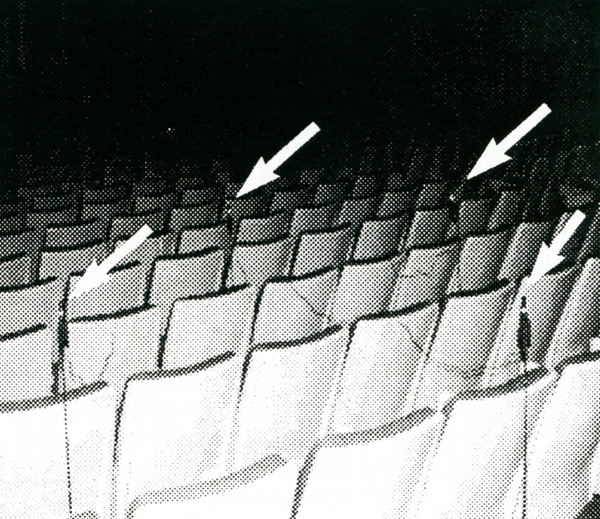 Microphones amid the seats for audio measurements in Galaxy screen # 2. Picture by Paul Rayton. Microphones amid the seats for audio measurements in Galaxy screen # 2. Picture by Paul Rayton.• There is a concept, or theory, so to speak, as to where to place the four microphones in the auditorium. However, not all cinemas are exactly the same size and shape, and there is no absolutely specific placement chart: every time the rooms are re-tuned, the microphones end up being placed in slightly different locations. These different placements can obviously have some influence on what's heard...which influences what's seen on the RTA...which influences how the levels get set... • There are differences in the test films: some are issued by the SMPTE, some are made by Dolby. Some test films have been used by technicians for (what appears to be) years, others are new from the lab. All of these have various production dates, and possible laboratory variations... And so, the tests and settings which on the surface appear to be totally scientific are, in reality, a bit subjective. Theoretically, on a Monday, I could have Disney studios in for a screening of some sort. Disney projection engineers are usually accompanied by a Dolby "Field Applications Engineer", and we would tune the house "just right" for them, using the Dolby-preferred microphones and a Klark Teknik RTA analyzer. And then, on Tuesday, I could have a technician from our service support company (NCS, National Cinema Service) come in, on contract for a studio like MGM -- and re-tune everything for MGM, using different microphones and an Ivie RTA. And then on Wednesday morning, I could have Universal Studios in for their screening, and we would re-tune everything a THIRD time(!), this time using their Lucasfilm/THX "R2" computerized RTA and the Countryman microphones. | |
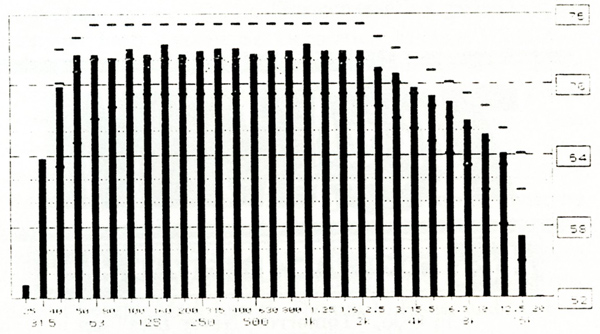 Fig A: Hollywood Galaxy Cinema 4 THX center channel typical frequency response as averaged between 4 listening michrophones. Fig A: Hollywood Galaxy Cinema 4 THX center channel typical frequency response as averaged between 4 listening michrophones.And at the end of all this, is the sound adjusted? Yes. Is it adjusted correctly? ... That, I guess, depends on who you are asking and where the microphones were placed! Luckily, this nightmare three-times-in-a-row scenario has never occurred, but I've had several instances with two daily re-tunings back to back. No matter how hard we try to isolate each and every detail, there is still margin for interpretation and opinions. Perhaps the best value of THX, at least as it relates to cinemas, is the requirement that the auditorium maintain certain standards having to do with external and air conditioning noise levels, and certain acoustical characteristics having to do with the interior of the room itself and its reverberation time. Accompanying illustrations show samples of some of the measurements taken. Fig A is a typical stage speaker channel frequency response chart, as averaged between the 4 listening microphones. Fig B is a display of the background noise levels that the THX program looks for -- and how our cinema #4 appeared on June 18, 1996. Fig C shows the reverberation time for our cinema #4 that day. We were comfortably in the safe zones in all areas, even with the air conditioning fans running. (Trace line represents the maximums allowed). There are other tests also performed as well. | |
 Fig B: Hollywood Galaxy Cinema 4 average background noise levels. Fig B: Hollywood Galaxy Cinema 4 average background noise levels.It would seem, then, that we leave nothing to chance in our cinemas. Even with the best of plans, however, things occasionally can go awry. For instance, we occasionally shift prints between the various cinemas, as dictated by seating requirements for the various special screenings. When we do this, we try to add (or remove) the THX logo film from the beginning of the feature. However, once in a while, there are last minute changes, because a special show has too many (or too few) people wishing to attend. It is not unknown for us to have to switch prints between cinemas just 5 or 10 minutes before showtime. (Thankfully, this happens rarely!) But in the course of this shuffling, the placement of the THX logo gets "out of sync" with the actual cinemas. So, one day, we had a situation as described, and had to run a film in cinema #4 before getting a THX logo on the print. Well, wouldn't you know ... there is always a "know-it-all" around: this day, we had some patron in the house who saw the show, knew "all" about THX, left the theatre and proceeded to call THX/Lucasfilm in San Francisco to complain that "the THX is turned off" at the Galaxy. This scientific observation of his was based on not seeing the logo at the start of the film. How do you explain to people like that (who know it all) that you cannot "turn off" a wall and all the design specifications?!?! We also encounter the occasional folk who could be called the "THX junkies". These are people who seem to not care about the sound of the feature film, only that the THX logo is played as loud as it can be, short of destroying every amp in speaker in the place! And, yes, they complain if it is seems low. The reality is, of course, that in a multiple-screen situation, we seldom have time to stand near a volume control for several minutes, waiting for that precise moment to boost the sound for that one logo, so it must play at the level that works for the feature film. (I have seem some cinemas with PC-based automation systems; these are capable of setting individual levels for selected bits of film.) | |
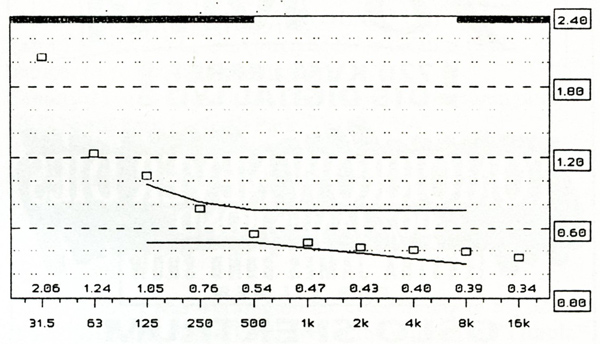 Fig C: Hollywood Galaxy Cinema 4 reverberation time. Fig C: Hollywood Galaxy Cinema 4 reverberation time.In the final analysis, is "THX" worth the extra cost? That's a hard question to answer, seeing as how I'm not the one spending the extra money to make sure the auditorium meets the THX standards. It does seem to have a "plus" factor with the moviegoing public, and, as a strictly unscientific comparison, listening to films in our various cinemas, as the prints move around, it does seem that THX adds something, especially with films such as "Twister" where sound design is important to the emotional impact. The word seems to be that cinema companies must pay something upwards of $500 per year per screen to license the use of the name "THX". Theoretically, they can't advertise their films as being "in THX" if they haven't been certified as being in compliance "recently". One US cinema corporation, Cinemark, has reportedly decided to stop paying the fee, and therefore is not advertising THX, even though a good number of their cinema screens were constructed to THX standards. The matter of the re-certifications is also somewhat of a gray area: who performs the "re-certs", and does a given cinema pass or not? If the technician performing the "re-cert" is in the employ of the cinema company, will he be honest as to the performance of everything, or, if something "minor" is off, will he cheat on the readings a bit to save his company money? And, I've heard reports that some "select" cinemas have been failed by field engineers, only to be told that, "Yes, that cinema passes"! This is a result of internal politics between the owners and THX, apparently. So, some "THX" may be better than others. Here in Hollywood, there are those of us who question the certification of the original Chinese theatre, because the room itself has a terrible problem with reverberation time (and sound is, truth be told, hard to understand). But there it is in the ads: Presented in THX. Really? Interestingly, the three most important big screen film venues in Hollywood are not THX certified, but they meet the most critical demands of equipment and acoustical testing: • The "Academy" Theatre (Samuel Goldwyn Theatre of the Academy of motion Picture, Arts & Sciences [The organisation that presents the "OSCARS"]) • Screen Directors Guild • Academy of Television Arts & Sciences. These are built with the "THX wall" theory of cinemacoustical design, but they select their own high-end audio components (which may or may not be THX "approved") for the rest of the system. These venues cannot tinker with reproduction quality for reasons of saving a few pennies, as, sooner or later, every director, editor, sound engineer, and every other job category that contributes to making the movies will have occasion to be in there, and you can be sure they'll complain if things aren't "perfect"! But none of these sites are officially "THXd"! | |
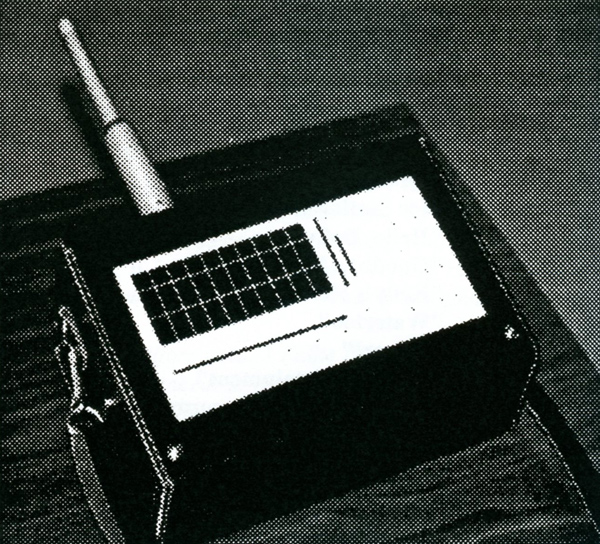 Abacus Real Time Analyzer (RTA). Picture by Paul Rayton. Abacus Real Time Analyzer (RTA). Picture by Paul Rayton.Getting those improved standards of presentation into commercial cinemas are, finally, the real reason for all the THX efforts. It would be nice if they broadened their efforts to encourage higher standards in the appearance of the image on the screen (i.e., push for 70mm film production and releases) as well as sound system performance. A recent article in "Boxoffice" magazine hinted that this would be happening. That's why I personally find so troubling the dilution of the THX "standards" into home video and videotapes. Many people now have "THX approved" speakers with their home video systems, but I can guarantee you, the experience is not the same as listening to that twister roar across the large theatre screen. It may say "THX" on that video speaker, but all the other components that enter into successful theatrical, dramatic, motion picture presentation are completely out of control. One has to wonder if they have been a bit too hasty in letting everybody put "THX" on all that video equipment. Even more distressing, I've seen "THX" on video tapes. If Joe Customer plays that "THX" tape on his cheap home video system, which may not even have THX-certified home equipment, what will THX do for him? Virtually nothing. It will still look and sound about the same. And so, what will his expectations be the next time he goes to a THX cinema or, more importantly, thinks about going out to a movie, and debates whether to go see it in a THX cinema, or a "regular" cinema? • Go to Life With THX In Hollywood Part 1 • Go to Paul Rayton In Conversation | |
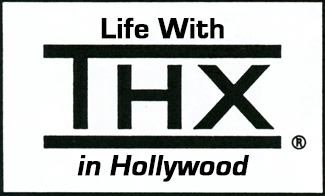 • Go to Life With THX In Hollywood Part 1 • Go to Life With THX In Hollywood Part 2 | |
| Go: back - top - back issues Updated 19-05-25 |
